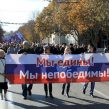
Russia Holds First ‘Unity Day’ Celebrations in Annexed Crimea
Publication: Eurasia Daily Monitor Volume: 11 Issue: 204
By:

Since the Russian government instituted a new holiday in 2005, ostensibly to promote patriotism and celebrate the 1612 liberation of Moscow from Polish forces, nationalists have commandeered this “Unity Day” holiday, which takes place every November 4, to hold a “Russian March” that promotes ethnic-Russian nationalism and sometimes even neo-Nazism (see EDM, November 1, 2013). The introduction of Unity Day nearly a decade ago was widely seen by observers of Russian politics as a reaction to the Orange Revolution in Ukraine in 2004/2005—a saga that arguably reached its climax only in 2014, with the Euromaidan protests. It is therefore ironic that this year’s holiday—and the xenophobic “Russian March” that was planned to accompany it—was celebrated in the newly-annexed, ethnic-Russian majority territory of Crimea. Furthermore, the 2014 Russian March revealed the success of the Kremlin’s strategy in commandeering the nationalist opposition and swinging it behind official Kremlin causes.
The officially sponsored march in Sevastopol in the newly-annexed territory of Crimea drew around 20,000 participants. The march began with a ceremony at a World War II memorial, with the laying of flowers. Armed with Russian flags, youth shouted slogans, including “if we are united, we will be victorious,” “In a united nation is a united country,” and “with Russia always!” Evening activities included the late-night opening of an art museum and a free concert titled “We Are United” (Rossisskaya Gazeta, November 4). In the Crimean capital of Simferopol, hundreds of residents of the city turned out for a demonstration in support of the Russian authorities. The leader of Crimea’s regional council, Sergei Aksenov, told the crowd: “Thank God that we returned home, to Russia, to our historical motherland… I am glad to greet you on the day of Russian military fame, the day of national unity!” (Rossisskaya Gazeta, November 4).
In previous years, Russian nationalist movements opposed to the government would hold their Russian Marches in parallel to the officially sanctioned ceremonies held on the Day of National Unity. Such nationalist demonstrations allowed these radical groups to publicly show their opposition to the Kremlin. And while opposition nationalist organizations did plan two marches in Sevastopol and Simferopol this year, they do not seem to have been successful.
In Sevastopol, the Russian March was scheduled to begin near Young Communist Square and then proceed down Lenin Street. The march was supposed to be joined by all pro-Russian organizations in the city (Allcrimea.net, October 27). In particular, the Movement Against Illegal Immigration (known by its Russian acronym, DPNI) planned to host a presentation for march participants. In Simferopol, the marchers were planning to hold a demonstration and a meeting outside of the Crimean government building (krymr.com, October 17). The leading role of the DPNI in planning the march should come as no surprise given the active involvement of DPNI members in the ongoing fighting in Ukraine’s far eastern Donbas region (see EDM, June 11). The DPNI has been at the forefront of efforts to oppose the Russian regime, and its leadership is involved in the “Russkiye” organization—the rump of a once larger political group opposing the Kremlin. However, the unofficial nationalist events on the Crimean peninsula were either of such small size as to receive no media attention or they did not go ahead, suggesting the limited appeal of the nationalist opposition in Russia’s newest region.
In Moscow, on the other hand, there were three separate marches. The first was by the official (sanctioned) “opposition” parties—the Liberal-Democratic Party of Russia (LDPR), A Just Russia (SR) and the Communist Party of the Russian Federation (CPRF)—which ended in a concert in support of the “Novorossiya” (“New Russia”) project (vk.com/sputnikipogrom, November 4). The guest of honor at the march was scheduled to be the former leader of the Donetsk People’s Republic, Igor Girkin (a. k. a., Strelkov). But Strelkov announced on the day of the march that he would not be attending. According to reports, he said he did not agree with the positions of the organizers of the action (Newdaynews, November 4). The official march in support of Novorossiya brought an estimated 75,000 supporters onto the streets.
At the same time, a neo-Nazi Russian March took place in the Moscow suburb of Lublyino and drew between 5,000 and 7,000 participants waving flags emblazoned with swastikas and variants of that symbol. The marchers shouted “for Donbas” and “save Kievan Rus,” in support of Russia’s actions in Ukraine. Russian neo-Nazi leaders Alexander Belov and Dmitry Demushkin were in attendance. Explaining the lower turnout than in previous years, Demushkin told a reporter that “obviously our chief nationalist [meaning, Russian President Vladimir Putin] draws people away. A certain role is played by Novorossiya, connecting the epithets of ‘Banderovites’ and ‘fascists’ to [Ukrainian] nationalists. No one wants to associate with those on the margin” (Moskovsky Komsomlets, November 5).
Lastly, a third march in Moscow, this one against the war with Ukraine, drew approximately 1,500 people. The peace march failed to attract nearly as much media coverage as the other two public demonstrations that took place that day in the Russian capital.
In all, the message to take away from the Russian marches on November 4, 2014, is that Putin’s efforts to commandeer the nationalist bandwagon—and to wrestle support away from the anti-Kremlin opposition—appear to have been successful. Nonetheless, the disparate factions that tried to mobilize competing marches during this year’s Unity Day celebrations across the Russian Federation still represent a potential danger for the Putin regime. Indeed, the very success the government has had in quelling the domestic opposition suggests that Putin may not be able to stop stirring trouble amongst ethnic-Russian populations in neighboring states lest such hesitation reawaken and refocus the radical nationalist movements inside Russia itself.




